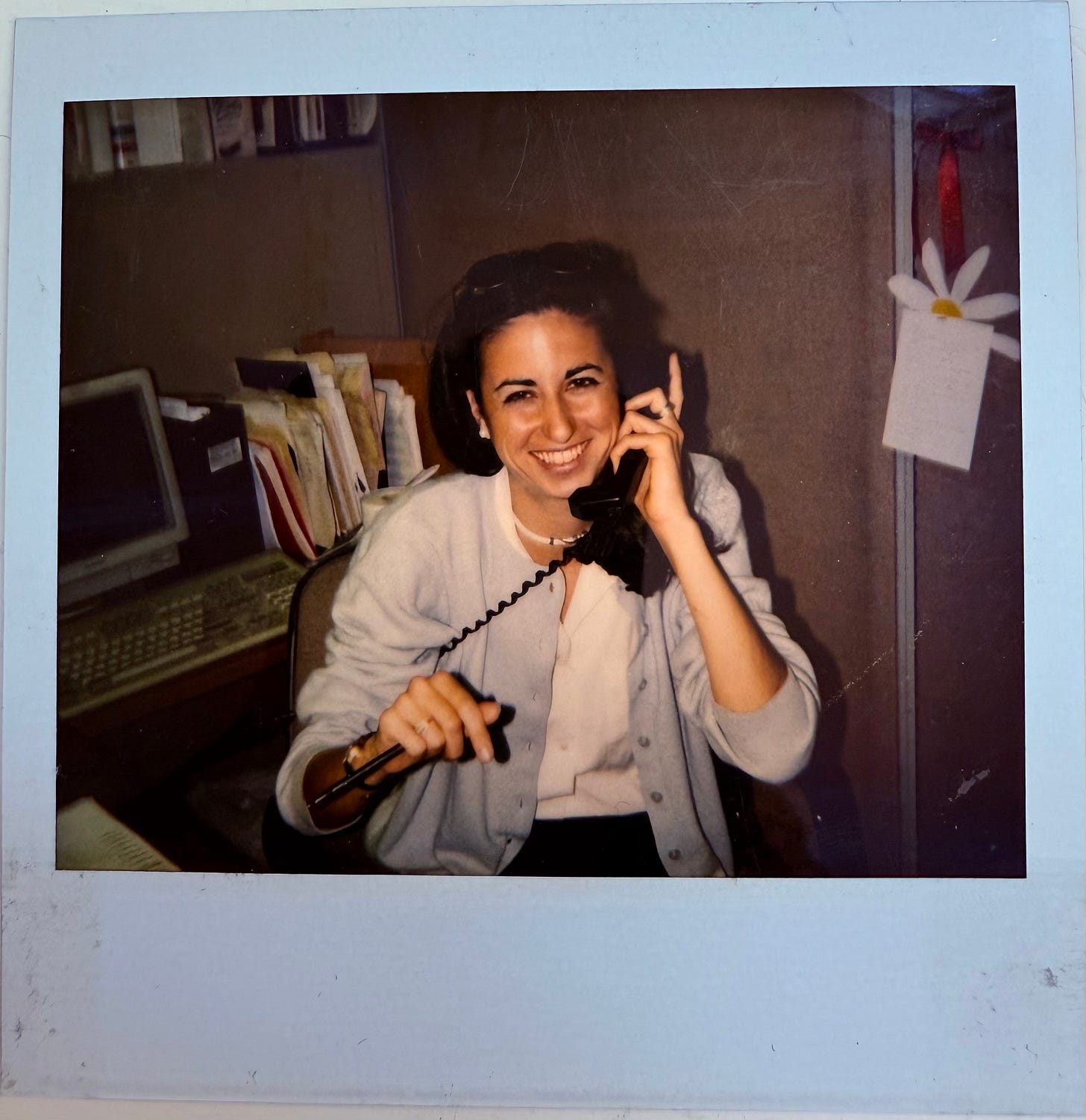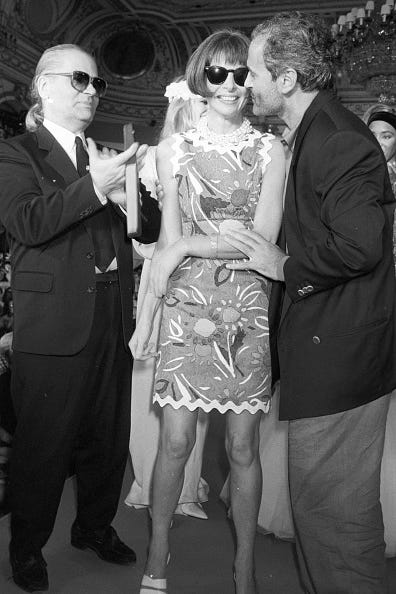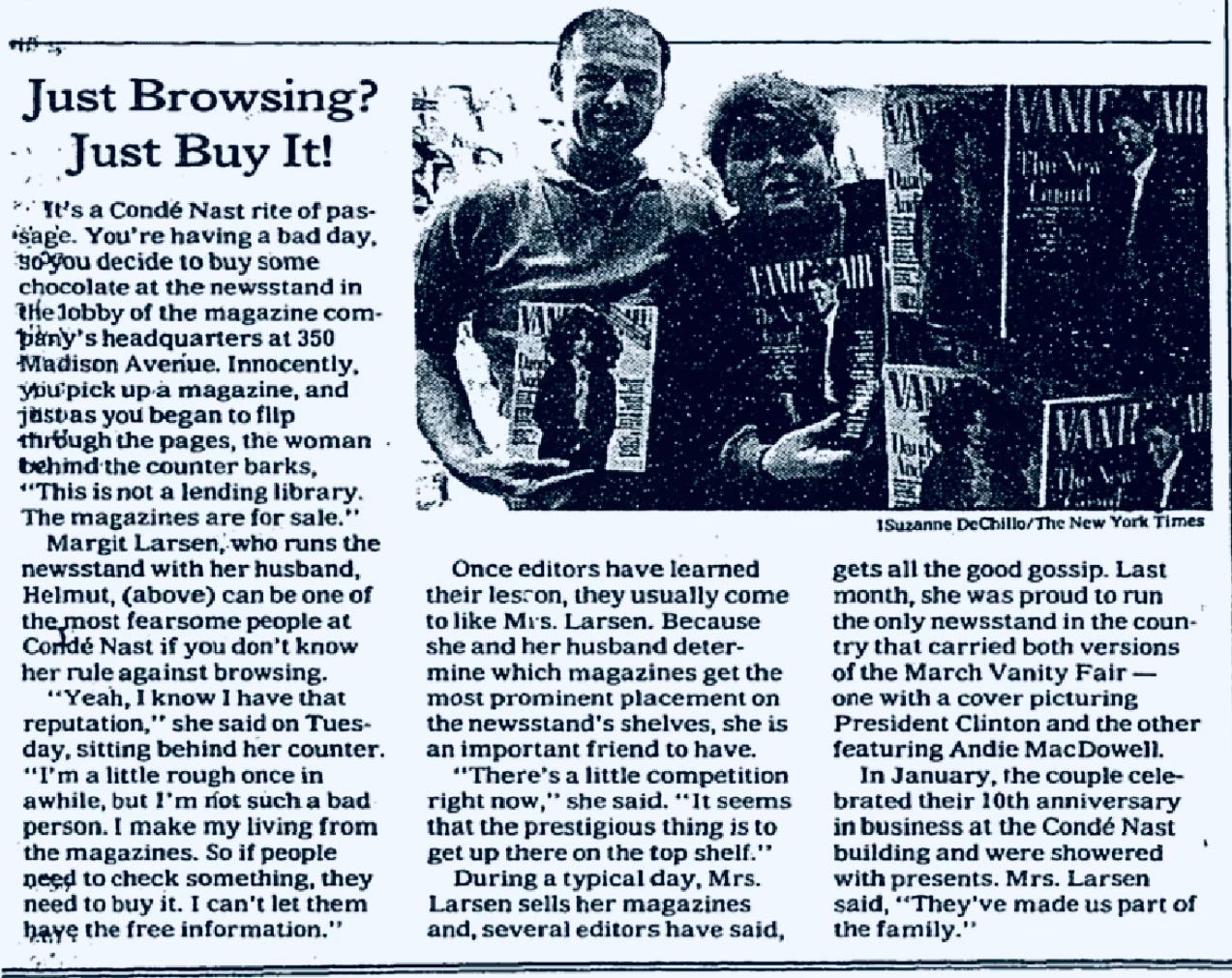Core Curriculum #5: Peak 90s Inside Condé Nast's castle & kingdom.
Meet our monitors Margit and Helmut- Graydon Carter quite agrees.

Power is not as it appears
Only years later, do I find it strange that Margit and Helmut, the colorful couple who owned Condé Nast’s lobby newsstand, made a living selling magazines and newspapers, to those who ran a magazine and newspaper empire.
That should have been my first clue that there was much more than meets the eye with regard to their position, in this drippingly glamorous mix.
Si Newhouse presided over Advance Publications, a company that he and his family owned lock, stock, and barrel. Advance Publications owned a larger collection of media assets, which at the time included a newspaper group, and Condé Nast.
Condé Nast seemed to us at the time like Si’s favorite child in the family, and published magazines which back then included Vogue, Vanity Fair, Glamour, GQ, Architectural Digest, Mademoiselle, Gourmet, and Self. Most of these magazines, Vogue included, were housed at 350 Madison Avenue in Manhattan.
Lesser revenue generating titles in that moment, like Condé Nast House & Garden, Wired, and Details, were farmed out to another building located steps away.
Si, while physically diminutive in size, was otherwise larger than life, and sat (we believed) somewhere ensconced within 350 Madison. Si enjoyed blowing a breeze, and every so often a cyclone, through his castle and kingdom.
And since his presence in our lives was always felt, yet he was rarely seen, a “Si sighting” — in the lobby, or in an elevator — was big news at Vogue, and was always reported in to our 12th floor offices.
If Si was the Wizard, his media empire was Oz. Condé Nast was Dorothy, and Advance’s newspaper group was Toto.
350 Madison Avenue was definitely The Emerald City.
As a corporate perk, Condé Nast employees were given every in-house magazine they asked for, every month, and for free.
Yet assistants, on both the advertising and editorial sides, made multiple visits every day to Margit and Helmut’s newsstand — which sat in its own corner of Condé Nast’s lobby. Returning to their individual offices — towering stacks of magazines and newspapers in hand, in short skirts and high heels- was hard work.
These buying sprees were an official part of every assistant’s job description, and this gathering exercise always included the purchase of one’s own magazine’s “competitive titles.” So, if for example, you worked at Vogue, you and your boss were buying Harper’s Bazaar (a Hearst publication) to keep a close eye on what they were up to. And no matter which magazine you worked for, The New York Post was in the pile for its “Page Six” gossip column.
For the fashion set, obscure titles like Visionnaire, whose price per issue at the time was hundreds of dollars, were somewhere in the stack. Each Condé Nast magazine had its own house account with Margit & Helmut, and was billed directly by them every month.
Margit was plump, brusque, spoke with a pronounced German accent, and handled all transactions. She favored dreary synthetic pant and top separates in muddy colors, and tragically sensible shoes. Helmut was tall, thin, also spoke with a German accent, and did everything else. Most days, he wore ratty jeans, a t-shirt, and running shoes since he was always on the go.
Margit presided over the cash register and rang up sale after sale. While Helmut spent from dawn until dusk bringing goodness only knows what else (to include fresh juices and candy) to individual offices, since special orders for delivery could also be called in. When not making the rounds, Helmut re-stocked the shelves and the refrigerated beverage case, to keep up with the constant demand.
The real value of Margit and Helmut was that they were completely woven into the fabric of daily life at Condé Nast. They knew everything, in real time.
Either one could tell you whose career was looking up, and whose was in a downward spiral — from entry level, all the way up to luminary.
They knew who was getting a big promotion next week, and who had just had their head handed to them six seconds ago. Everyone within the empire fed breaking news into Margit and Helmut all day, everyday.
So if you wondered what was cooking behind closed doors, at your own magazine in real time, you took the elevator down to see Margit and Helmut for the update.
And since they were the human tickers of who was up- and who was down- within the organization at any given moment, for so many reasons, Margit and Helmut were important people to know at Condé Nast.
The Lesson: Power is not always as it appears. The people who weild true influence within an organization may not be immediately obvious to you. They could be hiding in plain sight.
Pay close attention when you are new to a company, and identity its clandestine information brokers, since absolutely every organization has them. Make an effort to weave interactions with these people into your day; even if in the beginning it feels scary to do so.
Due diligence digs up the unexpected
Still on the subject of Margit and Helmut…Pity the poor person who stopped by their newsstand to casually flip through anything, without buying it first!
Stories made the rounds of Margit’s head practically popping off as she shrieked at the top of her lungs — and perhaps physically assaulted publication flipping perpetrators- while running them out of her prized corner of Condé Nast.
Worse, these scenes were terribly public. Since Margit and Helmut’s newsstand sat directly across from the only elevator bank in the building that everyone (and I mean everyone) used to access their office upstairs.
So news of a Margit blow-up spread like wild fire, in real-time, all over Condé Nast.
I first heard about Margit and Helmut in my interview process for Vogue. During approximately two years, it had taken me several attempts to get this close to an offer from Condé Nast. So for this third (and God willing final) round of things, I left absolutely nothing to chance in preparing for my next visit.
I called ahead to trusted friends who worked in the building, to tell them that I was coming to interview with Condé Nast HR. Again.
To remind them of just how desperate I was to work for Vogue.
Everyone who already worked there gave me the same advice: “When you arrive in the lobby and find yourself with a few minutes to kill, for God’s sake do not visit the newsstand to flip through anything. If you do, horrible things will happen, and your meeting will not go well.”
When I later worked at Vogue, we gave the same exact advice, when friends called to share that they had an upcoming meeting in the building.
But one day, a colleague received a call from her college frenemy, who relayed that she had an upcoming job interview at Condé Nast. This friend of mine matter-of-factly told her nemesis that when walking into the building “it’s best to show interest by flipping through magazines at the lobby newsstand, before going up to meet with HR.”
The day and time of the frenemy’s visit arrived, and we all sat upstairs on the edge of our seats — waiting for a report of a Margit explosion. At the appointed hour, news of one of course came in. Well-deserved or not, our friend’s friend received some serious comeuppance that day.
And naturally said frenemy did not get the job.
The Lesson: Excellent career advice often comes from the most unexpected places.
Only those who did full front-end due diligence, through trustworthy and carefully selected sources, knew to avoid a visit to the newsstand when meeting with anyone at Condé Nast.
And when asked for advice, those of us on the inside filed this nugget under the heading “critical.”
“Are you going to buy dat?”
Below please find an excerpt from Graydon Carter’s just released auto-biography “When The Going Was Good” which includes his own memories of Margit and Helmut- and vividly back up mine. If you have not yet read “When The Going Was Good”- I beyond recommend. From page 142 of Graydon Carter’s new release:
“I was constantly worried that I was going to lose my job [at Vanity Fair]. The only encouragement I got was from Si. An editor is only as good as the support of his or her proprietor. And here, Si had no peers. If he ever wobbled over his decision to hire me, he never showed it.
There was a newsstand in the lobby of 350 Madison run by a slightly quirky husband-and-wife pairing, Margit and Helmut. She was on the large side, and he was tall and thin. A Jack Sprat couple, as Aimée [Graydon’s colleague] used to call them.
They were from the old country, though I was never sure of which country. Germany seemed to be the consensus. Margit and Helmut ruled their domain like the Ceauşescus had Romania. Merely reaching for a magazine would result in “Are you going to buy dat?”
Most important, they knew everything that went on at Condé Nast long before anyone else did. Their newsstand was on the right just before you turned the corner to go to the elevators. It was impossible to miss.
Just before you got to them, there was one of those old-fashioned black address boards with horizontal seams and white plastic letters spelling out executives’ names and their floor numbers. Si’s was at the top. And farther down came the publishers and editors.
Every morning during those first couple of years, I would glance discreetly to my right to make sure that my name was still on the board. Then I’d say hello to Margit and Helmut. I figured they would know first if I was on my way out. I’d be able to gauge my fortunes just by the look on their faces. That’s how tenuous I felt my residency at Vanity Fair was.”
The Lesson: Were Margit and Helmut Si Newhouse’s in-house spies extraordinaire who trafficked in internal information as part of some corporate master plan? We don’t know. But the savviest at Condé Nast knew to filter information through these two, and saw them as invaluable allies.

Celebratory send-offs
On Wednesday July 16, 1997 at 6:00 pm I tip-toed through Condé Nast’s lobby- distracted by thoughts of taking SEVEN whole weekdays/workdays off from Vogue in the next week and a half.
I was using (almost) all of my vacation time to get married on Saturday, July 19, 1997 to an incredibly adorable- and very handsome- human treasure. And I was beside myself about our upcoming honeymoon in Paris, and Belle-Île-En Mer in Brittany.
A 6:00 pm departure from Vogue on any given day was seen as “early.” So I tried to slip out unnoticed. And as I said my usual evening goodbyes to Condé Nast’s Security Desk — steps from our front door — I thought I had pulled it off.
Until I heard someone loudly shout: “MARIA!!! COME. HERE.”
I re-grouped. And turned around in the direction of the voice.
It was Margit. With Helmut standing obediently alongside. As I approached, Margit uttered solemnly, “we’ve been waiting for you.”
Margit handed me an envelope, and then shrieked: “We are so happy for you!!! So happy and proud! ENJOY every moment!!!! And please return with photos!!!” Margit gave me hugs, and Helmut too. They both grinned ear-to-ear.
I thanked them, walked out of the building, and when I was a few blocks away I opened the envelope. Inside was an adorably cheesy Hallmark card signed “Congratulations on Your Wedding Maria! Love Margit and Helmut.”
Margit and Helmut terrified most people upon their arrival at Condé Nast. And rightly so.
But if one formed an authentic connection with them, everything changed. They kept an eye on you, and became invaluable internal allies within the empire.
When Condé Nast moved from 350 Madison Avenue to 4 Times Square in January 2000 — and announced to the press (I mean?!?) that they had not asked Margit and Helmut to move with them to the new building— I immediately wondered how my friends at Vogue would now survive.
The Lesson: From Margit and Helmut I learned the value of human capital. I learned to collect information ongoing, file it away, and make sense of it later. And I learned to carefully select my sources.
So in this moment of mail-it-in-from afar/work-from-home, Megan McArdle’s 2023 piece in The Washington Post- in which she coined the phrase “Lazy Girl Jobs,” her column strikes a chord.
And yes, of course I hate its sexist title. But sadly I agree with its premise.
Per Megan McArdle’s much discussed piece, “a lazy girl job is remote and pays your bills without demanding too much of your time, or that you be at work at any particular time.” The author continues, “I do wonder how happy people seeking low-intensity remote jobs will be with this decision 10 or 20 years down the road…might this be a good short-term decision that has significant long-term costs?”
In other words, how are you really learning, growing, and developing critical personal and professional skills while you sit by yourself at home, generating “output,” without receiving any real human feedback? And, in too many instances these days, without meaningfully engaging in the real world?
At Condé Nast, we were battle-tested daily. Lessons were learned, skill sets were organized, shortcomings identified (and strengthened), talents and abilities unleashed.
All because we were forced to spend (perhaps waaay too much) time together. We became individual and collective works in progress- whipped into shape by one another.
Learning to navigate this playground, within this group of (crazy) personalities, at times felt terrifying. Survival meant hustling, ducking and weaving, and always pulling it off with supreme personal panache.
These are not the critical life skills that one develops while sitting at home on the sofa. Just the opposite. As the saying goes, “No pain, no gain.” So get out there.
Maria Devaney graduated from Georgetown University in the 1990s, and would like to thank fellow alum Condé Montrose Nast who graduated in the 1890s from the same institution. Maria would also like to thank Franny Nast, Condé’s aunt, for funding his college education when his parents could not. Condé went on to become President of Georgetown’s student body, the same position for which (former U.S. President) Bill Clinton campaigned in the late 1960s- and lost.
After Georgetown, Condé worked for a college classmate’s father in magazine publishing, then broke off on his own in 1909 to acquire an obscure society publication called Vogue. Condé Nast, the man, built it into the media empire we know today.
“Everything You Need to Know I Learned at Vogue” began as a private letter to Maria’s (then small) daughter Margaux, and evolved into a four-year, on-campus workshop for students of The Georgetown Scholars Program (GSP) at Georgetown University in Washington, DC.




Finally getting a chance to catch up on reading. I loved the line about tragically sensible shoes. I can identify, since I have way too many of them in my own closer :) What an adventure Vogue must have been!